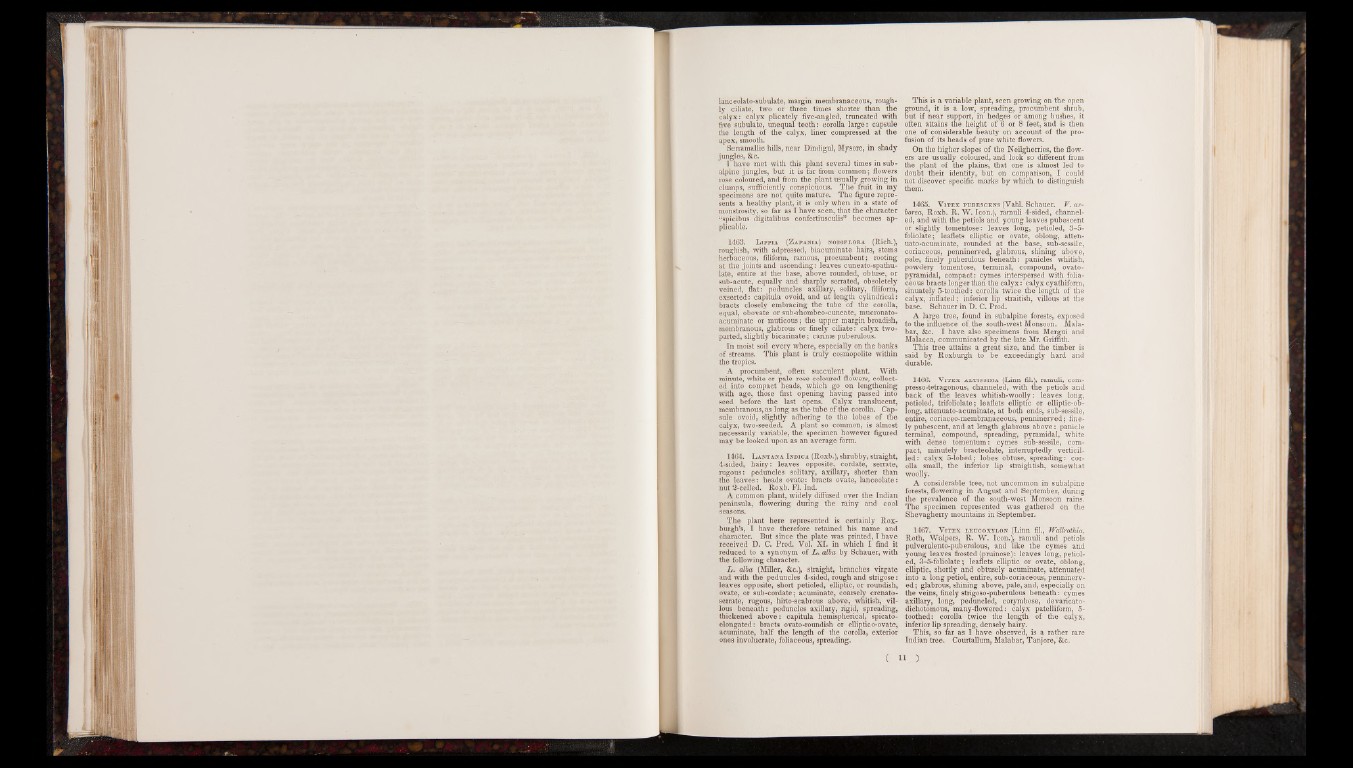
lanceolato-subulate, margin membranaceous, rough*
ly ciliate, two or three times shorter than the
calyx: calyx plicately five-angled, truncated with
five subulate, unequal teeth: corolla large: capsule
the length of the calyx, liner compressed at the
apex, smooth.
Serramallie hills, near Dindigul, Mysore, in shady
jungles, &c.
I have met with this plant several times in sub-
alpine jungles, but it is far from common; flowers
rose coloured, and from the plant usually growing in
clumps, sufficiently conspicuous. The fruit in my
specimens are not quite mature. The figure represents
a healthy plant, it is only when in a state of
monstrosity, so far as I have seen, that the character
“spicibus digitalibus confertiusculis” becomes applicable.
1463. Lippia (Zapania) nodiflora (Rich.),
roughish, with adpressed, biacuminate hairs, stems
herbaceous, filiform, ramous, procumbent; rooting
at the joints and ascending: leaves cuneato-spathu-
late, entire at the base, above rounded, obtuse, or
sub-acute, equally and sharply serrated, obsoletely
veined, flat: peduncles axillary, solitary, filiform,
exserted: capitula ovoid, and at length cylindrical:
bracts closely embracing the tube of the corolla,
equal, obovate or sub-rhombeo-cuneate, mucronato-
acuminate or muticous; the upper margin broadish,
membranous, glabrous or finely ciliate: calyx two-
parted, slightly bicarinate; carinae puberulous.
In moist soil every where, especially on the banks
of streams. This plant is truly cosmopolite within
thetropics. -
A procumbent, often succulent plant. With
minute, white or pale rose coloured flowers, collected
into compact heads, which go on lengthening
with age, those first opening having passed into
seed before the last opens. Calyx translucent,
membranous, as long as the tube of the corolla. Capsule
ovoid, slightly adhering to the lobes of the
calyx, two-seeded. A plant so common, is almost
necessarily variable, the specimen however figured
may be looked upon as an average form.
1464. Lantana Indica (Roxb.), shrubby, straight,
4-sided, hairy: leaves opposite, cordate, serrate,
rugous: peduncles solitary, axillary, shorter than
the leaves: heads ovate: bracts ovate, lanceolate:
nut 2-celled. Roxb. FI. Ind.
A common plant, widely diffused over the Indian
peninsula, flowering during the rainy and cool
seasons.
The plant here represented is certainly Roxburgh’s,
I have therefore retained his name and
character. But since the plate was printed, I have
received D. C. Prod. Vol. XI. in which I find it
reduced to a synonym of L . alba by Schauer, with
the following character.
L . alba (Miller, &c.), straight, branches virgate
and with the peduncles 4-sided, rough and strigose:
leaves opposite, short petioled, elliptic, or roundish,
ovate, or sub-cordate; acuminate, coarsely crenato-
serrate, rugous, hirto-scabrous above, whitish, villous
beneath: peduncles axillary, rigid, spreading,
thickened above: capitula hemispherical, spicato-
elongated: bracts ovato-roundish or elliptico-ovate,
acuminate, half the length of the corolla, exterior
ones involucrate, foliaceous, spreading.
This is a variable plant, seen growing on the open
ground, it is a low, spreading, procumbent shrub,
but if near support, in hedges or among bushes, it
often attains the height of 6 or 8 feet, and is then
one of considerable beauty on account of the profusion
of its heads of pure white flowers.
On the higher slopes of the Neilgherries, the flowers
are usually coloured, and look so different from
the plant of the plains, that one is almost led to
doubt their identity, but on comparison, I could
not discover specific marks by which, to distinguish
them.
1465. Vitex pubescens (Vahl. Schauer. V. ar-
borea, Roxb. R. W. Icon.), ramuli 4-sided, channeled,
and with the petiols and young leaves pubescent
or slightly tomentose: leaves long, petioled, 3-5-
foliolate; leaflets elliptic or ovate, oblong, atten-
uato-acuminate, rounded at the base, sub-sessile,
coriaceous, penninerved, glabrous, shining above,
pale, finely puberulous beneath: panicles whitish,
powdery tomentose, terminal, compound, ovato-
pyramidal, compact: cymes interspersed with foliaceous
bracts longer than the calyx: calyx cyathiform,
sinuately 5-toothed: corolla twice the length of the
calyx, inflated; inferior lip straitish, villous at the
base. Schauer in D. C. Prod.
A large tree, found in subalpine forests, exposed
to the influence of. the south-west Monsoon. Malabar,
&c. I have also specimens from Mergui and
Malacca, communicated by the late Mr. Griffith.
This free attains a great size, and the timber is
said by Roxburgh to be exceedingly hard and
durable.
1466. Vitex altissima (Linn fil.), ramuli, com-
presso-tetragonous, channeled, with the petiols and
back of the leaves whitish-woolly: leaves long,
petioled, trifoliolate; leaflets elliptic or elliptic-oblong,
attenuato-acuminate, at both ends, sub-sessile,
entire, coriaceo-membranaceous, penninerved; finely
pubescent, and at length glabrous above: panicle
terminal, compound, spreading, pyramidal, white
with dense tomentum: cymes sub-sessile, compact,
minutely bracteolate, interruptedly verticil-
led: calyx 5-lobed; lobes obtuse, spreading: corolla
small, the inferior lip straightish, somewhat
woolly.
A considerable tree, not uncommon in subalpine
forests, flowering in August and September, during
the prevalence of the south-west Monsoon rains.
The specimen represented was gathered on the
Shevagherry mountains in September.
1467. Vitex leucoxylon (Linn fil., WaUrolhia,
Roth, Walpers, R. W. Icon.), ramuli and petiols
pulverulento-puberulous, and like the cymes and
young leaves frosted (pruinose): leaves long, petioled,
3-5-foliolate; leaflets elliptic or ovate, oblong,
elliptic, shortly and obtusely acuminate, attenuated
into a long petiol, entire, sub-coriaceous, penninerved
; glabrous, shining above, pale, and, especially on
the veins, finely strigoso-puberulous beneath: cymes
axillary, long, peduncled, corymbose, devaricato-
dichotomous, many-flowered: calyx patelliform, 5-
toothed: corolla twice the length of the calyx,
inferior lip spreading, densely hairy.
This, so far as I have observed, is a rather rare
Indian tree. Courtallum, Malabar, Tanjore, &c.